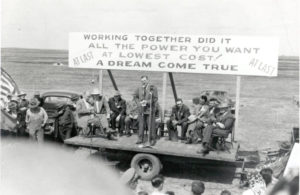
I attended a church service yesterday that inspired this post. Jordinn Nelson Long conducted the service as a guest minister this week and it had to do with hope, which I find to be an excellent topic as we head into the new year known as 2019. She gave us statistics, as a small part of the message, that would help us see there is reason for hope. She shared stories, poetry and images which were so uplifting, even exciting. So, I’m going to follow the model with different content.
In spite of the political arena, where observers on both sides of the issues find reasons for despair, there are many positives to encourage us as we start another year around the sun. Wal Van Lierop, a venture capitalist whose career has focused on “sourcing, investing in and helping to commercialize breakthrough innovations for energy intensive industries” writes for Forbes that cleantech investors such as himself have good reason to be optimistic about the future of the planet and humanity. He cites gains in clean energy technology and increased financial commitment around the world by private companies and governments to making these a practical reality. Also, he says 60% to 75% of students at top engineering schools are showing interest in getting involved with startups instead of giving their services to Silicon Valley businesses so dedicated to consumer apps. Venture capitalists are investing in those types of students and “increase the odds of funding meaningful projects in industrial innovation and cleantech.”
The polarization of our country is truly disturbing to me. The right, the left…the religious zealots, the non-believers…the young, the old…the upper class, the lower class…the corporations, the workers…on and on it goes. Our civilization could unravel if we don’t start finding common ground. It’s not just the commercial media that stirs the pot, though they may have been the culprits to get the pot boiling in the first place. The anger and hate have spread to the breeding ground called social media. Facebook and Twitter are the greatest examples. There’s a lot of love exchanged on them, but far too much outrage over others’ opinions. But, as Jonathan Rauch wrote in an latimes.com op-ed piece last week, signs of change for the better are coming to view. He is a member of Better Angels, where he sits on the board. It’s a national organization which is fostering unity among our divided citizens.

Rauch writes that Better Angels is “a national grassroots movement to depolarize the country, one community at a time. Committed conservatives and progressives — Donald Trump Republicans and Hillary Clinton Democrats — meet in structured workshops, not to change one another’s minds but to relearn how to communicate and connect as fellow citizens. After only a few hours, participants emerge able to see the humanity and positive intentions on the other side. Those angry partisans often become neighbors and friends.”
He goes on to describe how the concept they’re promoting is spreading across the country. Groups have popped up in 30 states and the District of Columbia. Almost 300 people have been trained to be moderators and they are able to train others. They’re doing this as it needs to be done, from a grassroots level. Rauch observes astutely, “Each new workshop not only plants seeds of local bipartisanship, but also broadcasts the empowering message that ordinary people can take action against our would-be dividers.” He mentions other similar groups, so I want to make sure their names are seen as well. They are Bridge the Divide and Living Room Conversations. Let us reach out to those who are doing the vital work of bringing us together. Perhaps the most encouraging development is the Problem Solvers Caucus, a bipartisan group in Congress that is promoting an honest intention to work together for the common good.
By many measures, the world and the people in it are improving. Crime rates are very low at this time. According to the Huffington Post, we are in the most peaceful time in world history. Wars are less frequent, less devastating and less violent. Teen pregnancy rates are way down. Poverty rates are still too high, but trending downward over the last 11 years. High school dropout rates are down to 6.1 percent, much better than 10.9 percent in 2000. The worldwide life expectancy rate in 1900 was 31 years. In 2014, it was 71.5.
There are many who are suffering and struggling mightily in this world. Even those who have all the advantages may be in depression, but I hope to have shown conditions can change. We can lend a hand to those who need it. We can live in gratitude and be the change we want to see in ourselves (a nod to Gandhi there). And we can spark the unity we need to have going forward in this country and across the world.
